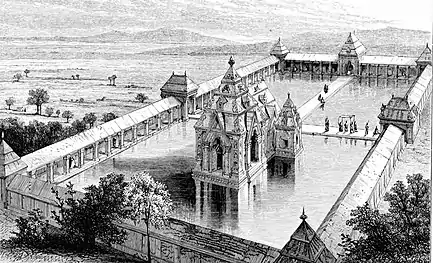Karkota Empire
Karkota Empire (c. 625 - 885 CE) was a major power in the Indian subcontinent during 7th and 8th century.[1][2] It was founded by Durlabhavardhana during the lifetime of Harshavardhan. The dynasty marked the rise of Kashmir as a power in Northern India.[3] Avanti Varman ascended the throne of Kashmir on 855 A.D., establishing the Utpala dynasty and ending the rule of Karkota dynasty.[4]
Karkota Empire | |||||||
|---|---|---|---|---|---|---|---|
| 625 CE–885 CE | |||||||
.jpg.webp) Karkota territory at its maximum extent, according to Joseph E. Schwartzberg's A Historical Atlas of South Asia | |||||||
| Capital | Srinagar (625-724) Parihaspore (724-760) Srinagar (760-885) | ||||||
| Religion | Hinduism | ||||||
| Government | Monarchy | ||||||
| Samraat (Emperor) | |||||||
• 598 CE - 634 CE | Durlabhavardhana (first) | ||||||
• 634 CE - 724 CE | Durlabhaka | ||||||
• 684 CE-643 CE | Chandrapida | ||||||
• 724 CE–760 CE | Lalitaditya Muktapida | ||||||
• 760 CE-763 CE | Kuvalayapida | ||||||
• 763 CE-770 CE | Vajraditya II | ||||||
| Historical era | Classical India | ||||||
• Established | 625 CE | ||||||
• Disestablished | 885 CE | ||||||
| |||||||
| Today part of | Afghanistan India Pakistan Bangladesh | ||||||
Part of a series on the |
|---|
| History of Kashmir |
 |
Lalitaditya Muktapida, the dynasty's strongest ruler captured parts of Central Asia, Afghanistan and Punjab.[5] According to Kalhana's Rajatarangini, Lalitaditya was able to extend the power of Kashmir beyond the normal mountain limits and in about 740 CE inflicted a defeat upon Yashovarman, the King of Kannauj. Kalhana further credits Lalitaditya with vanquishing the Turks, Tibetans, Bhutias, Kambojas and others.[6][7][8] Kalhana lived around four centuries after Lalitaditya, and popular imagination appears to have embellished Lalitaditya's achievements during this period, as evident from the fact that Kalhana credits the king with miraculous powers such as being able to produce water in desert by striking the sand with his sword.[9] For example, the claim of Lalitaditya conquering the Tibetans seems to be based on his participation in Tang campaigns against the Tibetans.[10]
The Karkota emperors were primarily Hindu.[11] They built spectacular Hindu temples in their capital Parihaspur.[12][13] They however also allowed Buddhism to flourish under them. Stupa, Chaitya and Vihara can be found in the ruins of their capital. Martand Sun Temple in the Anantnag district were built by Lalitaditya. It is the oldest known Sun temple in India and was also one of the biggest temple complexes at the time.[14]
_of_the_Karkota_dynasty_Circa_763-770.jpg.webp) Coin of king Vajraditya (Vigraha Deva) of the Karkota dynasty, c. 763-770 CE.
Coin of king Vajraditya (Vigraha Deva) of the Karkota dynasty, c. 763-770 CE..jpg.webp) Martand Sun Temple built by Lalitaditya Muktapida.
Martand Sun Temple built by Lalitaditya Muktapida. Restored impression of the temple by J. Duguid, 1870-73 CE.
Restored impression of the temple by J. Duguid, 1870-73 CE.
See also
Notes
- Ram, P. (December 2014). Life in India, Issue 1.
- Koul, Bill K. The Exiled Pandits of Kashmir: Will They Ever Return Home?. Springer Nature. p. 204. ISBN 978-981-15-6537-3.
- Kalhana (1147-1149); Rajatarangini.
- Sen, Sailendra Nath (1999). Ancient Indian History and Civilization. New Age International. p. 295. ISBN 978-8122-411-98-0.
- Wink 2002, p. 243.
- Manohar Lal Kapur (1992). The history and culture of Kashmir. Anmol. p. 27. ISBN 978-81-7041-619-7.
Thus we see that the conquests of Lalitaditya have been exaggerated by Kalhana much beyond the bounds of credibility.
- Mohibbul Hasan (2005). Kashmīr Under the Sultāns. Aakar Books. p. 54. ISBN 978-81-87879-49-7.
...Kalhana had two centuries earlier exaggerated the military exploits of his hero Lalitaditya...
- Manabendu Banerjee (2004). Historicity in Sanskrit Historical Kāvyas. Sanskrit Pustak Bhandar. p. 344.
Lalitaditya's alleged conquests over Uttarakurus and Strirajya are, according to Stain, purely mythological and so there is no need to trace historical elements in these conquests. While describing Lalitaditya's manifold victories Kalhana may be charged with occasional exaggeration and favouritism that were not unnatural for a court historian...
- Shyam Manohar Mishra (1977). Yaśovarman of Kanauj. Abhinav. p. 95. OCLC 5782454.
And as usually happens the achievements of Lalitaditya must have been coloured and exaggerated by popular imagination during the four centuries or so that intervened between Kalhana and the events of the reign of the Kashmir king. This is illustrated by the stories of Lalitaditya's miraculous powers recorded by Kalhana.
- Tansen Sen (2004). "Kaśmīr, Tang China, and Muktāpīḍa Lalitāditya's Ascendancy over the Southern Hindukush Region". Journal of Asian History. 38 (2): 141–142. JSTOR 41933381.
His diary, in addition to other contemporary Chinese and Tibetan sources, will be employed to revise the exaggerated perception of Lalitāditya's military achievements. It will be argued that the success of a series of joint Kaśmīri-Tang campaigns against the Tibetans, rather than any unilateral military conquests by Lalitāditya, may have accounted for the local legends about Kaśmīri hegemony in the southern Hindukush-Pamir area. Such local legends, in turn, seem to have been used by Kalhaņa to characterize Lalitāditya as the conqueror of the Turks and Tibetans.
CS1 maint: ref=harv (link) - Pal, Sayantani (2016), "Karkota dynasty of Kashmir", The Encyclopedia of Empire, pp. 1–2, doi:10.1002/9781118455074.wbeoe049, ISBN 9781118455074
- Animals in stone: Indian mammals sculptured through time By Alexandra Anna Enrica van der Geer. 2008. pp. Ixx. ISBN 978-9004168190.
- Gupta, Kulwant Rai (2006). India-Pakistan Relations with Special Reference to Kashmir By Kulwant Rai Gupta. p. 35. ISBN 9788126902712.
- Siudmak, John (5 April 2013). The Hindu-Buddhist Sculpture of Ancient Kashmir and its Influences. ISBN 978-9004248328.
References
- Wink, André (2002), Al-Hind, the Making of the Indo-Islamic World, 1, BRILL, ISBN 9780391041738